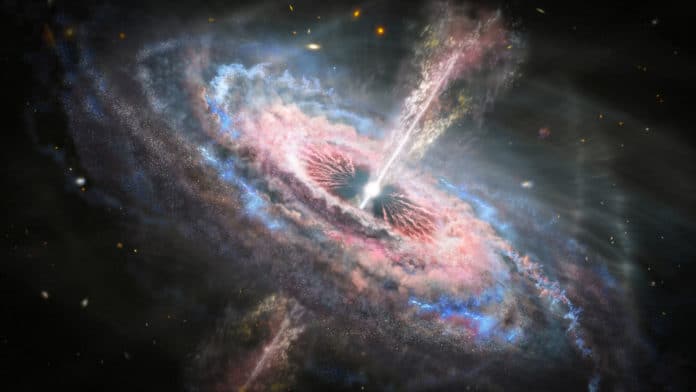Usually located at the centers of galaxies, quasars are the brightest objects in the universe. They feed on the infalling matter and unleash fantastic torrents of radiation.
Shortly after its launch later this year, a team of scientists will train NASA‘s James Webb Space Telescope on six of the most distant and luminous quasars. The telescope will use quasars and their host galaxies to unlock the secrets of the early universe.
In addition to studying the properties of these quasars, scientists will determine the interconnection between the galaxies and quasars during the first stages of galaxy evolution in the very early universe.
Santiago Arribas, a research professor at the Department of Astrophysics of the Center for Astrobiology in Madrid, Spain, said, “All these quasars we are studying existed very early when the universe was less than 800 million years old, or less than 6 percent of its current age. So these observations allow us to study galaxy evolution and supermassive black hole formation and evolution at these very early times.”
The expansion of space has stretched the light from quasars. This is known as cosmological redshift. The farther the light has to travel, the more it is redshifted. With its suite of infrared-tuned instruments, Webb is uniquely suited to studying this kind of light.
Along with being distant, the quasars that scientists will determine have the highest- black hole masses and have the highest black hole masses.
Chris Willott, a research scientist at the Herzberg Astronomy and Astrophysics Research Centre of the National Research Council of Canada (NRC) in Victoria, British Columbia, said, “We’re interested in observing the most luminous quasars because of the very high amount of energy that they’re generating down at their cores should lead to the largest impact on the host galaxy by the mechanisms such as quasar outflow and heating. We want to observe these quasars at the moment when they’re having the largest impact on their host galaxies.”
Using quasars as background light sources, Webb will study the gas between us and the quasar. Through a technique called imaging spectroscopy, they will look for absorption lines in the intervening gas.
By determining whether the gas is neutral or ionized, scientists will learn how neutral the universe is and how much of this reionization process has occurred at that particular point in time.
Team member Camilla Pacifici, who is affiliated with the Canadian Space Agency but works as an instrument scientist at the Space Telescope Science Institute in Baltimore, said, “If you want to study the universe, you need very bright background sources. A quasar is the perfect object in the distant universe because it’s luminous enough that we can see it very well. We want to study the early universe because the universe evolves, and we want to know how it got started.”
